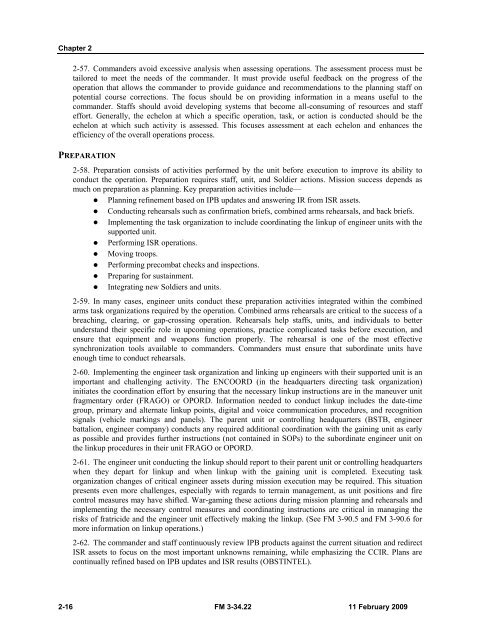FM 3-34.22 - Army Electronic Publications & Forms - U.S. Army
FM 3-34.22 - Army Electronic Publications & Forms - U.S. Army
FM 3-34.22 - Army Electronic Publications & Forms - U.S. Army
You also want an ePaper? Increase the reach of your titles
YUMPU automatically turns print PDFs into web optimized ePapers that Google loves.
Chapter 2<br />
2-57. Commanders avoid excessive analysis when assessing operations. The assessment process must be<br />
tailored to meet the needs of the commander. It must provide useful feedback on the progress of the<br />
operation that allows the commander to provide guidance and recommendations to the planning staff on<br />
potential course corrections. The focus should be on providing information in a means useful to the<br />
commander. Staffs should avoid developing systems that become all-consuming of resources and staff<br />
effort. Generally, the echelon at which a specific operation, task, or action is conducted should be the<br />
echelon at which such activity is assessed. This focuses assessment at each echelon and enhances the<br />
efficiency of the overall operations process.<br />
PREPARATION<br />
2-58. Preparation consists of activities performed by the unit before execution to improve its ability to<br />
conduct the operation. Preparation requires staff, unit, and Soldier actions. Mission success depends as<br />
much on preparation as planning. Key preparation activities include—<br />
� Planning refinement based on IPB updates and answering IR from ISR assets.<br />
� Conducting rehearsals such as confirmation briefs, combined arms rehearsals, and back briefs.<br />
� Implementing the task organization to include coordinating the linkup of engineer units with the<br />
supported unit.<br />
� Performing ISR operations.<br />
� Moving troops.<br />
� Performing precombat checks and inspections.<br />
� Preparing for sustainment.<br />
� Integrating new Soldiers and units.<br />
2-59. In many cases, engineer units conduct these preparation activities integrated within the combined<br />
arms task organizations required by the operation. Combined arms rehearsals are critical to the success of a<br />
breaching, clearing, or gap-crossing operation. Rehearsals help staffs, units, and individuals to better<br />
understand their specific role in upcoming operations, practice complicated tasks before execution, and<br />
ensure that equipment and weapons function properly. The rehearsal is one of the most effective<br />
synchronization tools available to commanders. Commanders must ensure that subordinate units have<br />
enough time to conduct rehearsals.<br />
2-60. Implementing the engineer task organization and linking up engineers with their supported unit is an<br />
important and challenging activity. The ENCOORD (in the headquarters directing task organization)<br />
initiates the coordination effort by ensuring that the necessary linkup instructions are in the maneuver unit<br />
fragmentary order (FRAGO) or OPORD. Information needed to conduct linkup includes the date-time<br />
group, primary and alternate linkup points, digital and voice communication procedures, and recognition<br />
signals (vehicle markings and panels). The parent unit or controlling headquarters (BSTB, engineer<br />
battalion, engineer company) conducts any required additional coordination with the gaining unit as early<br />
as possible and provides further instructions (not contained in SOPs) to the subordinate engineer unit on<br />
the linkup procedures in their unit FRAGO or OPORD.<br />
2-61. The engineer unit conducting the linkup should report to their parent unit or controlling headquarters<br />
when they depart for linkup and when linkup with the gaining unit is completed. Executing task<br />
organization changes of critical engineer assets during mission execution may be required. This situation<br />
presents even more challenges, especially with regards to terrain management, as unit positions and fire<br />
control measures may have shifted. War-gaming these actions during mission planning and rehearsals and<br />
implementing the necessary control measures and coordinating instructions are critical in managing the<br />
risks of fratricide and the engineer unit effectively making the linkup. (See <strong>FM</strong> 3-90.5 and <strong>FM</strong> 3-90.6 for<br />
more information on linkup operations.)<br />
2-62. The commander and staff continuously review IPB products against the current situation and redirect<br />
ISR assets to focus on the most important unknowns remaining, while emphasizing the CCIR. Plans are<br />
continually refined based on IPB updates and ISR results (OBSTINTEL).<br />
2-16 <strong>FM</strong> 3-<strong>34.22</strong> 11 February 2009

















